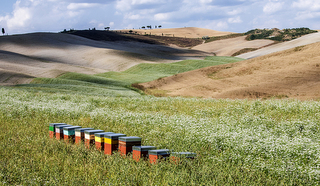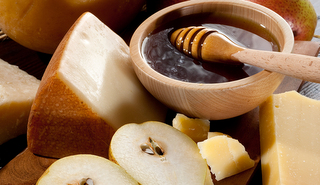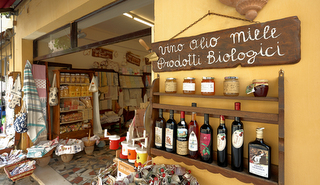One ingredient we always try to have on our lunchtime picnic tables is a taste of local honey. It is delicious on bread, with cheese or drizzled on a fresh apple or pear, and wherever we are walking in Italy we try to find the best, locally produced, organic honeys.
The Italians have not historically been huge consumers of honey, “miele” in Italian, but it was widely used as a remedy. Honey is mineral and nutrient-rich and different types of honey were believed to help the circulatory system, or to clean the liver, or to maintain the respiratory system, or to act as a cure for anaemia. In Sardinia, where the highly-prized Corbezzolo honey from the strawberry tree is consumed, the inhabitants are famously long-living, many making it to their 100th birthdays, so the proof may well be in the pudding!


It is thought that beekeeping in Italy began with the first Greek settlers in southern Italy in 700 BC, and certainly by Roman times it was well documented by writers and scholars of the era. Nowadays, honey is produced along the length of the peninsula. Many National Parks from the Maritime Alps in the north to the Pollino in the south offer uncontaminated environments, which are rich in flora and forested areas. Whether you like the classic millefiori, acacia, chestnut, eucalyptus, lavender or honeydew, Italy is making quality honey with special characteristics.
The Italian Beekeepers Association, (Federazione Apicoltori Italiani – FAI), has a Honey Seal of Warranty which identifies and selects excellent products and guarantees the authenticity of the source of the honey, it’s freshness and uniform crystallisation. Each year for over 40 years, on the outskirts of Bologna, the Tre Gocce d’Oro Competition is held. The “three drops of gold” contest celebrates the best of Italian honey, with different categories reflecting the story of Italy’s biodiversity. Recently over 500 beekeepers have taken part and it is an event which gains in popularity both with consumers and participants each year.
The area of the Lunigiana in Tuscany, where we hike on our Parma, Tuscany and the Ligurian Sea tour, is home to an Acacia honey which was the very first to be awarded the DOP certificate. This is Europe’s mark of origin which is attributed to foods whose characteristics depend on the territory where they are produced.


Honey is consumed more and more at breakfast time, and is used in cooking as a sweetener. A famous dish with honey comes from Naples and is known as Struffoli. These are little sweet dough balls fried and then dipped in honey and decorated with colored sprinkles and candied fruit. Many still say that the best way to enjoy Italian honey is with cheese and there are some classic pairings. Next time you’re in Italy why not try sweet Acacia honey with a salty Pecorino Romano cheese, or Lavender honey with Montasio cheese?
